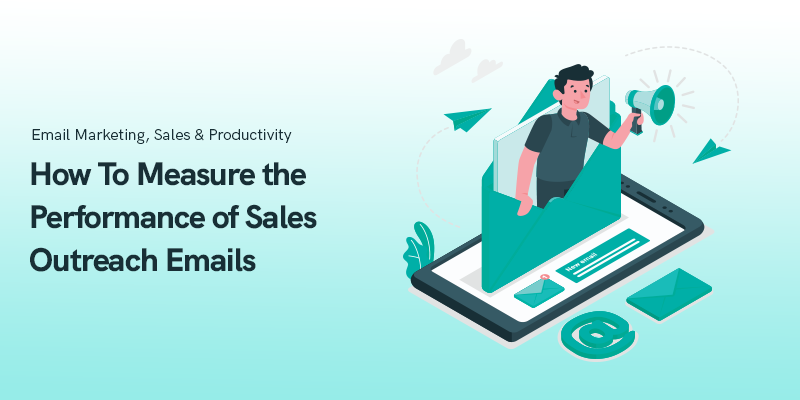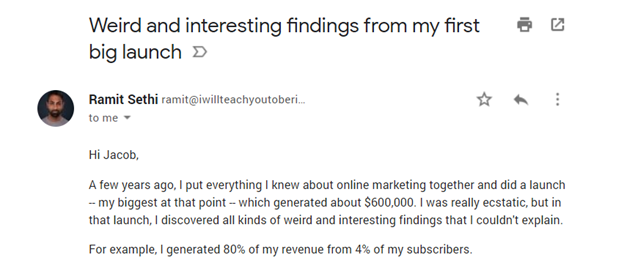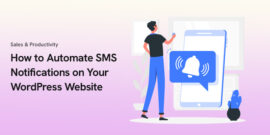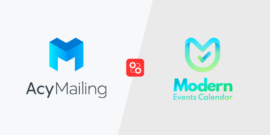
How To Measure the Performance of Sales Outreach Emails in 2025
Sales outreach is a technique you use to reach out to leads aiming to start conversations. Those conversations turn the prospects into paying customers or active subscribers. One of the most effective ways to initiate and conduct these conversations is through sales outreach emails.
Now, after sending out your emails, you need to keep track of various aspects to determine if the content is suitable for your audience and if your efforts in the campaign are paying off.
Some of the aspects to consider are on-mail metrics like opens, bounces, clicks, and unsubscribes. Others are off-mail metrics like conversion rate.
Read on to understand how to measure the performance of your sales prospecting emails.
Open Rate
Open rate is the percentage of email recipients who open an email you sent them. An email open rate of above 25% is generally considered good. However, these figures can change depending on your industry.
You can calculate the email open rate by dividing the emails opened by the total emails delivered.
Here’s the formula to calculate your email open rate percentage.
(opened emails÷total emails delivered)×100
If you have a low email open rate, you should consider the following;
Segment Your List
You can send emails based on previous purchases, demographics, or prospects.
Use tags to differentiate the different types of subscribers. This way, you will craft meaningful emails with personalized content for each group.
Use Catchy Subject Lines
Enticing subject lines make subscribers curious to open your email. You can use questions, statistics, and other techniques to achieve this.
Here’s an example you can learn from.

The screenshot shows how to use catchy headlines in your emails. When the target audience reads the combination of the words weird and interesting, they want to know what the sender is talking about.
Consider Your Timing
When it comes to sending emails, timing is crucial. Perform A/B tests to determine the best time subscribers open your emails.
Some email automation tools can also help you in determining this time and deploying your emails automatically. With management statistics showing employees are productive for only 2 hours and 53 minutes per workday, such automation is instrumental in enhancing the efficiency of your sales outreach team.
Avoid Spam Filters
To ensure your email marketing campaigns reach their maximum potential, you need to avoid being categorized as spam. You can do this by keeping all codes clean, showing your subscribers how to whitelist emails you send them, and ensuring all recipients opt in to get your emails.
Writing style
Write your email as if you are speaking to one individual, even though you send it to thousands of people. Use the buyer persona to understand their desires, values, problems, likes, and dislikes so that you can personalize your outreach emails accordingly. You also want to avoid buzzwords and instead use simple language and words to keep your audience engaged.
Bounce Rate
The bounce rates of your outreach emails indicate the percentage of emails that didn’t reach a subscriber’s inbox.
While it’s impossible to have no bounced emails, there is such a thing as good and bad bounce rates. According to Campaign Monitor, your email bounce rate should be anything between 2-5%. If it goes beyond that, you should look into your email marketing strategies and understand why so many of your emails bounce.
Here are some reasons that can make your email bounce:
- Blocked email address
- Invalid email address
- Full mailbox (on the subscriber’s end)
- The subscriber’s email server was experiencing downtime when you sent them an email.
Bounce rate is a crucial metric for determining the deliverability of all emails you send.
If you want to track your bounce rate, use cold email software to make the process seamless. These solutions notify you whenever your emails bounce.
To maintain a good bounce rate, it’s important that you clean your email list regularly. For example, if you’re targeting enterprise B2B SaaS customers, you must know that when someone leaves an organization, their corporate email address gets deactivated.
Some key decision-makers also change their corporate email addresses regularly. So verifying and cleaning your email list continuously will ensure these email addresses are removed to boost your email deliverability.
Conversion Rates and CTR (click-through-rate)
Conversion rate measures the percentage of email recipients who performed a desired action after reading your email. For example, they may have bought your product, scheduled a demo, or signed up for an event.
The main purpose of the conversion rate is to determine whether the efforts you put into your sales outreach emails are paying off. Additionally, it helps you adjust the content of your email to resonate with the audience’s needs.
Here is the formula used to calculate the email conversion rate:
Conversion rate formula:
Conversion Rate = (# of Conversions / # of Delievered Emails) x 100
Where # of conversions represents the number of people who took the desired action.
The click-through rate is another important metric showing the percentage of prospects who click one or more links in your sales outreach emails. The average CTR is 2.02%, but this figure varies depending on factors like the type of email, industry, location, and email campaign.
Here’s a formula to help you calculate CTR:
CTR = (Clicks / emails delivered) * 100
CTR provides a great way to measure your email engagements. The same techniques that enhance conversion rates can be used to boost email CTRs. Additionally, A/B testing your emails can help you increase the number of clicks your sales emails get.
Share and Delivery Rate
When subscribers relate to the content you send out in your sales outreach emails, they are likely to share the information with friends and family.
The email share rate shows the number of times your recipient shares your email using the ‘share this’ button. This metric helps you pinpoint which content is appealing to your target audience.
In addition, it can help increase brand awareness. As more people share your email content, more people will become aware of your offerings. This can also lead to a stronger online presence, especially on social media. It can help you get more LinkedIn connections, Instagram likes and followers, etc., depending on the social platforms your subscribers use.
Use this formula to calculate your share rate:
Email share rate = (Total no. of shares + total emails forwarded) / total emails delivered *100
When you identify the type of content that gets the most shares, you can replicate it in subsequent email marketing campaigns.
Meanwhile, the delivery rate measures the number of emails that actually reach your recipients’ inboxes. It’s calculated using the following formula:
Delivery rate = (Emails delivered / emails sent) * 100
Here are some factors that influence your email campaigns' deliverability.
- The infrastructure you use to send your emails
- Email volumes (smaller volumes have lower rejection rates)
- Bounce and spam traps
- Spam complaints from your subscribers
- Your email sender reputation
You need to be keen on these issues to make sure your email marketing campaigns are successful.
Even though a high delivery rate is good, you cannot afford to rest easy. Your email might be delivered and land in the spam folder instead of the inbox. If it ends up in the spam or junk folders, it will not be helpful. The recipient will not see it, which beats the purpose of the sales outreach.
Engagement Period
The email engagement period is the amount of time people spend interacting with your outreach email. Some of the common engagements include:
- Opening the email
- Clicking on links
- Reading the content
- Adhering to a call to action
You can track the engagement period through the open rates, “read, skim, delete” rates, click tracking, and heat maps.
“Read, Skim, Delete” is used to measure the time people spend on your email after opening it. Most email marketing tools have a feature that provides these statistics. Staying up to date with the latest email marketing trends allows you to utilize audience insights more effectively and enhance your email marketing efforts
This metric is essential because it helps you understand the engagement pattern so that you can adjust your email content and design accordingly.
Click tracking shows the number of times your subscribers click on a link embedded in your email. The analytics tool you use counts the number of total clicks and unique clicks, where unique clicks do not take into account repeated actions from the same user.
Lastly, heat maps visualize the most popular links of the sales outreach emails, which guides you on how to place your critical links in the future. The analytics tool uses different colors to represent the parts and links getting the highest interactions. For instance, green can be used to show a few clicks, yellow to represent medium clicks, and red highest clicks.
Complaint and Churn Rate
When subscribers don't like your emails, they might mark them as spam. The email service providers then start associating your email address with spam, affecting your entire outreach campaign.
Meanwhile, a high rate of complaints might get your account locked or penalized.
Ensure you track the number of complaints to avoid being penalized. Additionally, check for any technical or content errors that might lead to your email being marked as spam.
In sales outreach emails, the subscriber churn rate is the percentage of users who opt out of your list over time. Here is the formula used to calculate this metric:
Subscriber churn rate = (number of unsubscribers+bounces+complaints+inactive subscribers)÷total number of subscribers
You could be losing subscribers because they’re dissatisfied with the content and services they get from your business. Every subscriber has expectations when they join your list, and if those aren’t met, they churn. The best way to deal with this is to engage your subscribers constantly and understand how best to meet their expectations.
If your subscribers don’t feel a personal connection to your business, they're likely to churn. You’ll create a connection in the way you address them, the content you share with them, and how you respond to their queries and complaints.
You could also be experiencing a high subscriber churn rate if your competitors offer better business to your subscribers. Your subscribers want value-laced emails in their inboxes and matching services in your products. If they get this elsewhere, they’ll move. You can solve this problem by staying ahead of your competitors.
Another great way to avoid high complaint rates is to provide an unsubscribe option. This makes it easier for individuals who are no longer interested in your emails to opt out of your mailing list instead of marking the emails as spam or reporting them.
List Growth Rate
As the name suggests, the list growth rate is the pace at which your email list is growing. It's crucial because a growing list compensates for inevitable attrition and showcases your brand's expanding influence. Here is how it is calculated:
List growth rate = [(No. of new subscribers – (No. of unsubscribers + spam complaints)) / Total email addresses on your list] *100
A positive rate signifies net growth, while a negative indicates shrinkage.
To sustain a robust growth rate, focus on:
- Delivering consistent, high-quality content.
- Utilizing targeted marketing campaigns.
- Regularly purging inactive or unengaged subscribers.
A proactive approach ensures not just a growing list but an engaged and responsive audience.
Conclusion
When using email marketing as a sales technique, you must measure your sales outreach emails' performance regularly. The vital metrics you should track include the open rate, click-through rate (CTR), list growth rate, complaint and churn rate, conversion and bounce rate, and engagement time.
These aspects of your email campaigns show how customers interact with your content, indicating areas where you have succeeded and those that need improvement. You also identify customers' behavior and adjust your content and strategy appropriately.
Hopefully, the insights shared here will help you run more successful sales outreach email campaigns moving forward. To your success!
Recommended Posts

The Ultimate Guide to Effortlessly Automate SMS Notifications on Your WordPress Website in 2025
April 4, 2025

AcyMailing & MEC: A Seamless Integration Guide for 2025
January 28, 2025

Top 5 Email Marketing Tools for Event Promotion in 2025
January 21, 2025
